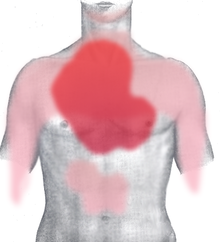Chest pain
| Classification according to ICD-10 | |
|---|---|
| R07.1 | Chest pain when breathing |
| R07.2 | Precordial pain |
| R07.3 | Other chest pain |
| R07.4 | Chest pain, unspecified |
| ICD-10 online (WHO version 2019) | |
The chest pain (also chest pain and chest pain ) is a common symptom in medicine with a variety of different causes of danger. The organs involved are primarily the heart , lungs , esophagus , and the muscular and skeletal systems of the chest . A dangerous or life-threatening cause can be ruled out promptly in specialized emergency rooms in cardiological departments, the so-called Chest Pain Units .
heart
Real coronary insufficiency
Discomfort caused by narrowing or occlusion of one or more coronary arteries in coronary heart disease
- Angina pectoris : dull, boring, pulling pain with tightness (Latin: angina), which is described as constricting or a great burden. Mostly behind the breastbone (Latin: pectus = chest), radiating into the left shoulder, less often into both shoulders, into the left arm and into the lower jaw. These pains are associated with fear (Latin root: angustus).
- Heart attack : as with angina pectoris, but usually more severe, with no improvement on nitroglycerin . Fear can turn into fear of death.
Relative coronary insufficiency
Circulation restriction of the coronary vessels without coronary heart disease with symptoms of typical angina pectoris
- Hypertrophic obstructive cardiomyopathy , decreased blood flow through the left ventricular outflow tract .
- Severe acquired aortic stenosis , decreased blood flow over the aortic valve
- Angina caerulea : pain associated with chronic cor pulmonale , possibly as an expression of a circulatory disorder of the right ventricle
- Syndrome X : Angina pectoris with a pathological stress ECG in healthy coronary arteries, most likely as a restriction of the coronary reserve with a good prognosis
- Tachycardia arrhythmia : precordial feeling of pressure
- Aneurysm spurium of the heart wall after myocardial rupture (tear of the heart muscle wall ) after infarction
- vasospastic Prinzmetal angina , pain like real angina pectoris
Others
-
Pericarditis : sharp, breath-dependent pain on the left side radiating to the neck, back and shoulder. Improvement of complaints when sitting bent over.
- bacterial or viral origin
- uremic origin or tubercular cause, rather painless.
- Dressler syndrome , a special case after a heart attack
- Aortic dissection of the thoracic aorta: therapy-refractory , suddenly shooting annihilation pain radiating to the back, neck , abdomen, possibly also legs
Lungs and pleura
- Pulmonary embolism : annihilation pain with accompanying dyspnoea, smaller embolisms often without pain
- Pleurisy : breath-related pain
- Tumor : slowly increasing pain
- Spontaneous pneumothorax : sudden onset of shortness of breath accompanied by breathing-dependent pain
esophagus
- Reflux esophagitis : burning pain behind the breastbone, often in the evening or at night, improvement when sitting or standing and after drinking fluids
- Esophageal spasm : pain behind the breastbone, regardless of food intake or posture, including at night
- Achalasia : diet-related retrosternal pain
- Mallory-Weiss syndrome and Boerhaave syndrome : retrosternal pain after vomiting
- Zenker's diverticulum : pain after swallowing
stomach
- Roemheld Syndrome : Pain after excessive meals, especially flatulent foods
- Gastritis , pain more in the upper abdomen
Skeletal system
- Spinal column syndrome : pain dependent on movement and posture, possibly with relieving posture
- Intercostal neuralgia : punctual or streak-shaped movement-dependent pain that can be amplified by pressure.
- Tietze syndrome : selective pain on pressure of the sternal cartilage attachments of the first and second, less often the third and fourth ribs
- Chest trauma and rib fracture : pressure and movement-dependent pain in a localized area
- Bone metastasis : selective pressure pain
- SAPHO syndrome : usually unilateral pain in the joint between the clavicle and sternum
- Eosinophilic granuloma : partly stress-dependent, partly also nocturnal localized bone pain
Musculature
- Myogelosis : punctual pressure pain in the hardened muscles, often next to the spine
- Dermatomyositis : symmetrical muscle pain
- Trichinosis : punctual muscular tenderness, possibly with palpable calcifications
Psychosomatic
- functional chest pain, heart anxiety , Da Costa syndrome
- Mental stress perceived as physical " heartache ", e.g. B. Lovesickness
Others
- Herpes zoster : sometimes very painful burning sensation in a circumscribed dermatome
- Pancreatitis , pain in the upper abdomen
- Biliary colic , colic-like pain usually radiating to the right shoulder
swell
- Christian Mewis, Reimer Riessen, Ioakim Spyridopoulos (eds.): Kardiologie compact . 2nd Edition. Thieme, Stuttgart / New York 2006, ISBN 3-13-130742-0 , pp. 1-3 .
Individual evidence
- ↑ Joachim Fichter: Langerhans cell histiocytosis in adults - an interdisciplinary challenge . In: Deutsches Ärzteblatt . April 19, 2007 ( aerzteblatt.de [accessed March 25, 2009]).


